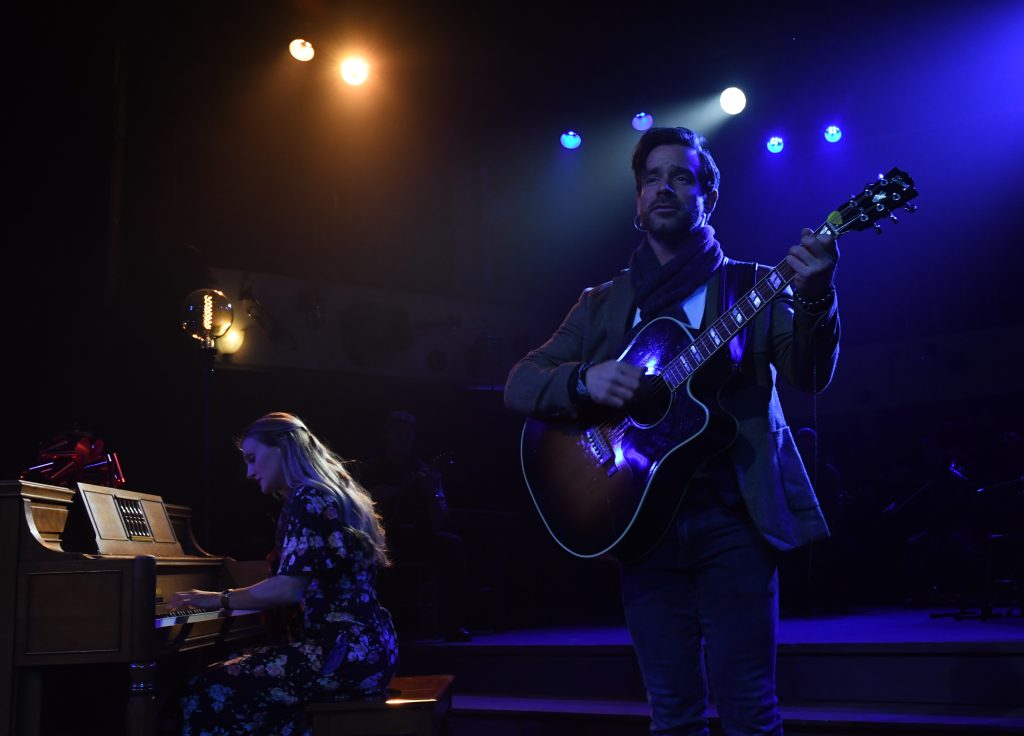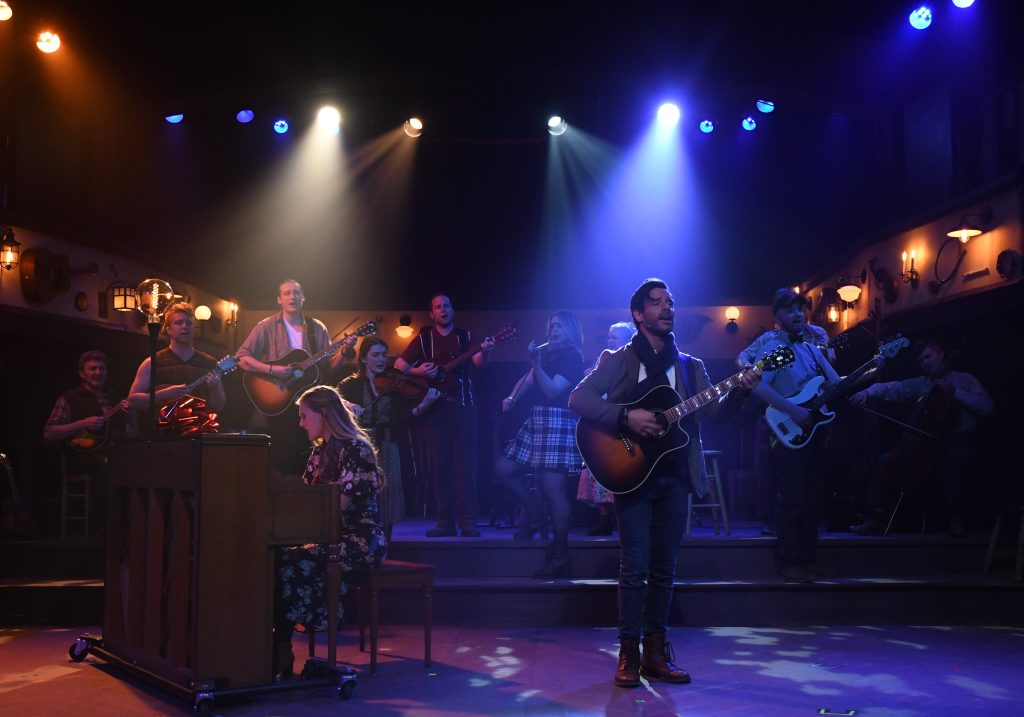For the Love of the Irish, Look No More than PMT’s ‘Once’
- Like
- Digg
- Del
- Tumblr
- VKontakte
- Buffer
- Love This
- Odnoklassniki
- Meneame
- Blogger
- Amazon
- Yahoo Mail
- Gmail
- AOL
- Newsvine
- HackerNews
- Evernote
- MySpace
- Mail.ru
- Viadeo
- Line
- Comments
- Yummly
- SMS
- Viber
- Telegram
- Subscribe
- Skype
- Facebook Messenger
- Kakao
- LiveJournal
- Yammer
- Edgar
- Fintel
- Mix
- Instapaper
- Copy Link

A play with music, ‘Once’ is a love story in which romance reverberates through song, not sex. Kate Queen and David Toole barely touch, but their chemistry is alive and alluring. (Photo: Matt Polk)
Girl meets sad Guy; Girl inspires Guy; Guy falls in love with Girl. Which makes her sad, and Guy goes home. The plot of Once is as simple as its title and central characters’ names. Beginning on a street in Dublin, an Irish busker (Guy) lays down his guitar, and calls it quits; that is, he needs to move on from the wrenching pain of singing songs of love once lost. But before he can escape from the darkness of the street, a young woman (Girl) calls to him. She has been deeply touched by his lyric cries of anguish and defeat.
Love and Sorrow Double-down in Dublin Town
But Pittsburgh Musical Theater’s production of Once—the 2012 Broadway success originally produced as a 2007 film—doesn’t start there. As the audience anticipates an evening of intimate songs embracing a soft love story, the stage is alive with ten musicians stomping out Irish classics, like “The Pride of Petravore” and “Whiskey in the Jar,” a tribute both to the play’s setting as well as to Irish celebrations everywhere in the season of St. Patrick’s Day. The pre-performance is also a surprise. The joyous, seemingly impromptu concert sets up a jarring juxtaposition when the lights dim low to follow a single, demoralized guitarist, pouring his heart onto the empty street.
Yet, Guy, played with emotional bravado by David Toole, commands the night. A fine guitarist with an even better voice, he stands in defiance of his palpable emotions, reasoning only with the Girl, who controls his indifference by offering just a wee dram of hope. The Girl identifies as a Czech trained-artist and she assures us her intentions are more musical than romantic. She proves her talent by playing a no-nonsense sonata on a piano she covets in an adjacent music shop. The Girl, played by Kate Queen who performs on the keyboard with as much confidence as her vocals are strong, sets both the pace and action of this love story.
A Night at the Pub, and the Gang’s All Here

Led by David Toole (as Guy) on the guitar and Kate Queen (Girl) on the piano, a rousing orchestra of ten strums, stomps, and stuns. (Photo: Matt Polk)
Tucker Topel’s set is understated and fluid. At once an Irish pub, at times a banker’s office, a recording studio, a music shop, an apartment bedroom, a city street, and a rocky shoreline, the stage is open and appropriately inviting. And, yet, it is always filled with the charm of Dublin and the music for which Ireland is revered. As suggested earlier, that space comes alive with a full and remarkable orchestra of competent and courageous musicians. There are two fiddlers, four guitarists, a mandolin player, cellist, accordionist, and a percussionist with both a full set of drums and a box to beat on, too. Which is both relevant and ironic because this ensemble of musicians who also sing and dance just can’t be beat. Even harmonizing a cappella, they are a credible and charming chorus. As if they need do more, they also play street characters, often serving in scenes to propel the story line. Even though their comic repartee may at times fall flat or their brogue sound forced, this production will stand on its own because of their collective contributions.
John Carney’s original film was reborn on Broadway in 2012 after a regional workshop and an off-Broadway run, which contributed to its eleven Tony nominations of which eight were won, including Best Musical, Best Actor, and Best Book (by Enda Walsh). For audience members familiar with the film, the stage adaptation changes much in the delivery of the story’s actions, setting, and plot-propelling characters. A film can pace time easier than a play. On stage, there are no prompts for “later that night” or “the following morning,” and, as such, theater audiences may get a bit lost. Curiously, director Tim Seib projects Czech translations on the upstage wall which oddly, and perversely, translate the English heard into Czech text. Only at the conclusion of the second act does any of that business make sense, yet with insufficient payoff.
Sorrow in Song Steals the Show
Although Once may have won a Tony as Best Musical, the staged story is really a play with music. Songs aren’t delivered to transform character nor are they designed to reveal dramatic irony. But, written by Glen Hansard and Markéta Irglová, they are beautiful and cathartically so. Memorable songs include “The Moon,” “Gold,” and “When Your Mind’s Made Up,” but “Falling Slowly” is the showstopper and will linger with audiences long after the lights are down.
Credit for Craft
Astounding credit is due Dr. Francesca Tortorello, Music Director, for bringing together an awe-inspiring orchestra and chorus. To pull that off, like credit is owed to Sound Designer Eric Collins for allowing the musicians to roam freely, most instruments being individually mic’d, as are all thirteen stage voices. Forrest Trimble delivers a fine lighting design, important on an open set which must serve so many purposes. And choreographer Larry A. Lozier, Jr. delivers strong and purposeful dance schemes in which the chorus delivers even more power than their instruments. Credit, too, goes to Alex Righetti for Costume Design, Amber Kocher for Props, Christopher Patrick for Wig and Makeup, Jonathan T. Sage and Kevin Kocher for Technical Direction, and Gemma Williamson for Stage Management. Colleen Doyno, Executive Director of Pittsburgh Musical Theater, also produced this theatrical triumph.
Once is a sensitive production of artistic melancholy, made joyous by so many accomplished musicians working in true harmony.
Once runs until April 2 in Pittsburgh Musical Theater’s Gargaro Theater. Visit PMT on the web for tickets and details, including the dates of special after-show concerts. 327 S. Main St., West End.
Prentiss Orr writes about theater for Entertainment Central. He has worked in theater management and has also taught theater. His latest book, The Surveyor and the Silversmith, is a history of white settlement, genocide, and land speculation in Western Pennsylvania.
Share on Social Media
- Like
- Digg
- Del
- Tumblr
- VKontakte
- Buffer
- Love This
- Odnoklassniki
- Meneame
- Blogger
- Amazon
- Yahoo Mail
- Gmail
- AOL
- Newsvine
- HackerNews
- Evernote
- MySpace
- Mail.ru
- Viadeo
- Line
- Comments
- Yummly
- SMS
- Viber
- Telegram
- Subscribe
- Skype
- Facebook Messenger
- Kakao
- LiveJournal
- Yammer
- Edgar
- Fintel
- Mix
- Instapaper
- Copy Link
Follow Entertainment Central
Sign up for the EC Newsletter
Latest Stories







